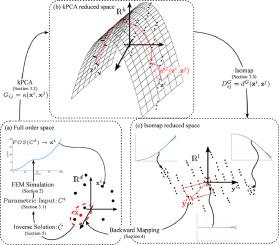A non-intrusive data-driven approach towards a solution of the inverse problem of bending dielectric elastomer actuators
IF 4.4
2区 工程技术
Q1 ENGINEERING, MULTIDISCIPLINARY
引用次数: 0
Abstract
Dielectric Elastomer Actuators (DEAs), particularly bending DEAs, have gained significant attention due to their applications in soft robotics, biomimetic systems, and adaptive structures. Recent advancements in computational mechanics and the finite element method (FEM) have enabled accurate simulations of these actuators by incorporating their nonlinear mechanical behavior at large deformations and the coupling between mechanical and electrical responses. However, DEA design often involves solving inverse problems, which become computationally expensive when relying solely on direct simulations. To mitigate this cost, a fast surrogate model is needed. This study proposes a Reduced Order Model (ROM)-based methodology to efficiently determine the optimal locations and magnitudes of applied external potentials in a bending DEA to achieve a desired displacement response. The approach leverages nonlinear dimensionality reduction techniques, specifically Kernel Principal Component Analysis (kPCA) and Isometric Mapping (Isomap), to construct a surrogate model that accurately predicts DEA displacement responses from existing data without modifying the underlying FEM formulation. Using this surrogate model, the inverse problem is solved efficiently, achieving high accuracy (<2 % error) while significantly reducing computational cost. The methodology is validated on two different bending DEA geometries, demonstrating its effectiveness in both surrogate modeling and time-efficient inverse problem solving.

一种非侵入式数据驱动方法求解弯曲介质弹性体作动器逆问题
介电弹性体致动器(dea),特别是弯曲致动器,由于其在软机器人、仿生系统和自适应结构中的应用而受到了极大的关注。计算力学和有限元方法(FEM)的最新进展,通过结合这些执行器在大变形下的非线性力学行为以及机械和电响应之间的耦合,可以精确地模拟这些执行器。然而,DEA设计通常涉及求解逆问题,当仅依靠直接模拟时,计算成本会很高。为了降低这个成本,需要一个快速代理模型。本研究提出了一种基于降阶模型(ROM)的方法,以有效地确定弯曲DEA中应用外部电位的最佳位置和大小,以实现期望的位移响应。该方法利用非线性降维技术,特别是核主成分分析(kPCA)和等距映射(Isomap),构建代理模型,在不修改基础FEM公式的情况下,从现有数据准确预测DEA位移响应。使用该代理模型,可以有效地求解逆问题,在显著降低计算成本的同时,实现了较高的精度(误差<; 2%)。该方法在两种不同的弯曲DEA几何上进行了验证,证明了其在代理建模和时间效率逆问题求解方面的有效性。
本文章由计算机程序翻译,如有差异,请以英文原文为准。
求助全文
约1分钟内获得全文
求助全文
来源期刊

Applied Mathematical Modelling
数学-工程:综合
CiteScore
9.80
自引率
8.00%
发文量
508
审稿时长
43 days
期刊介绍:
Applied Mathematical Modelling focuses on research related to the mathematical modelling of engineering and environmental processes, manufacturing, and industrial systems. A significant emerging area of research activity involves multiphysics processes, and contributions in this area are particularly encouraged.
This influential publication covers a wide spectrum of subjects including heat transfer, fluid mechanics, CFD, and transport phenomena; solid mechanics and mechanics of metals; electromagnets and MHD; reliability modelling and system optimization; finite volume, finite element, and boundary element procedures; modelling of inventory, industrial, manufacturing and logistics systems for viable decision making; civil engineering systems and structures; mineral and energy resources; relevant software engineering issues associated with CAD and CAE; and materials and metallurgical engineering.
Applied Mathematical Modelling is primarily interested in papers developing increased insights into real-world problems through novel mathematical modelling, novel applications or a combination of these. Papers employing existing numerical techniques must demonstrate sufficient novelty in the solution of practical problems. Papers on fuzzy logic in decision-making or purely financial mathematics are normally not considered. Research on fractional differential equations, bifurcation, and numerical methods needs to include practical examples. Population dynamics must solve realistic scenarios. Papers in the area of logistics and business modelling should demonstrate meaningful managerial insight. Submissions with no real-world application will not be considered.
 求助内容:
求助内容: 应助结果提醒方式:
应助结果提醒方式:


